The following outlines an integrated system for care planning in SystmOne. It has been designed to support palliative care, avoiding unplanned admissions DES, care of frail patients, dementia care and other areas.
The system is designed on the basis that many of the elements required in the various care plans are common e.g. problem summaries, contact details, medication, allergies, mental capacity act information etc. There is therefore a core structure that contains the common elements which can then be built upon with more specific sections.
The advantage of creating an electronic care planning process is that all clinicians using SystmOne would be able to see and update the care plan, facilitating better communication between teams, the patients, and carers. Many elements of the online care plan will be automatically updated using the relevant information from the record e.g. medication, problem lists, allergies.
Care Planning
Set-up
Add a Coordinated Care recall type to your system if you wish to use this function.
Ensure the following patient status alerts are activated at your unit:
- CC Coordinated Care
- CC Virtual Ward
- CDRC Has a DNACPR – with review date in the future
- CDRC Has a LPA
- CDRC Has an ADRT
- CDRC Has an IMCA
- CDRC Has DOLS order
- Has a DNACPR – review date expired
Patient Status Alerts
The care planning module includes Patient status alerts (icons) for:
- Patients with an IMCA (legal balance icon)
- Patients with an advanced directive to refuse treatment (legal balance icon)
- Patients with a DOLS order (legal balance icon)
- Patients with a power of attorney (legal balance icon)
- Patients with a DNACPR code and a DNACPR Review date in the future (black spot icon) to the left of the GMS icon
- Patients with a DNACPR code without a DNACPR Review date in the future (black spot icon) to the right of the GMS icon.

Templates
Coordinated Care Template
The Coordinate Care template aims to help improve care for patients by ensuring key information about the patient’s condition and wishes/goals are discussed and available to all clinicians. It is likely to be especially helpful for more complex patients such as those with dementia, palliative care needs, frailty and multi-morbidity.
How to Access:
In the lower left hand corner use the search bar, type in ‘Coordinated Care CDRC’ and select the following template:

Alternatively, press F12 and search for ‘Coordinated Care’, this will open the aforementioned template.
The Home Page of the template provides an overview of some key information. This screen can also be used to record ongoing discussion about patients including clinical or MDT meetings.
The first section allows recording of a thumbnail sketch to provide a brief introduction to patient’s main issues. The summary can be written using the Write Summary button or updated by right clicking on the summary and choosing Copy Questionnaire.
Coordinated Care and Palliative Care recalls will be shown in the recall box. This allows you to create a list of patients to be reviewed at the appropriate interval.
The central section includes some key interventions that are commonly appropriate in complex patients. There is also a view showing some key statuses such as whether the patient has dementia, frailty etc. Use the buttons to deliver the interventions/assessments or change the statuses.
The lower panel shows some key care planning information on the left and key legal and safeguarding information on the right. Again use the button to amend this information.
The EHCP button allow recording of more details patient wishes and emergency planning.
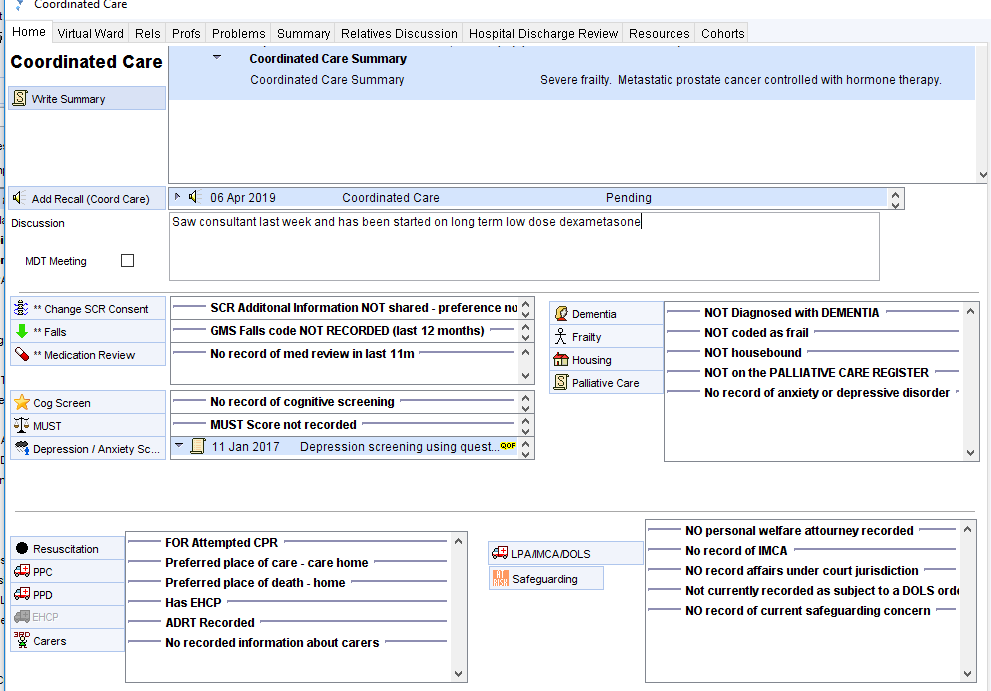
Additional information included in the Coordinated Care Template are spread across the following pages:
Relatives / Carers
The Rels/Carers page displays current recorded family relationships, carers (unpaid and paid, which allows recording of care package) and whether the patient has consented to sharing of his/her medical information with relatives. Use the buttons to add new relatives or update carer details.
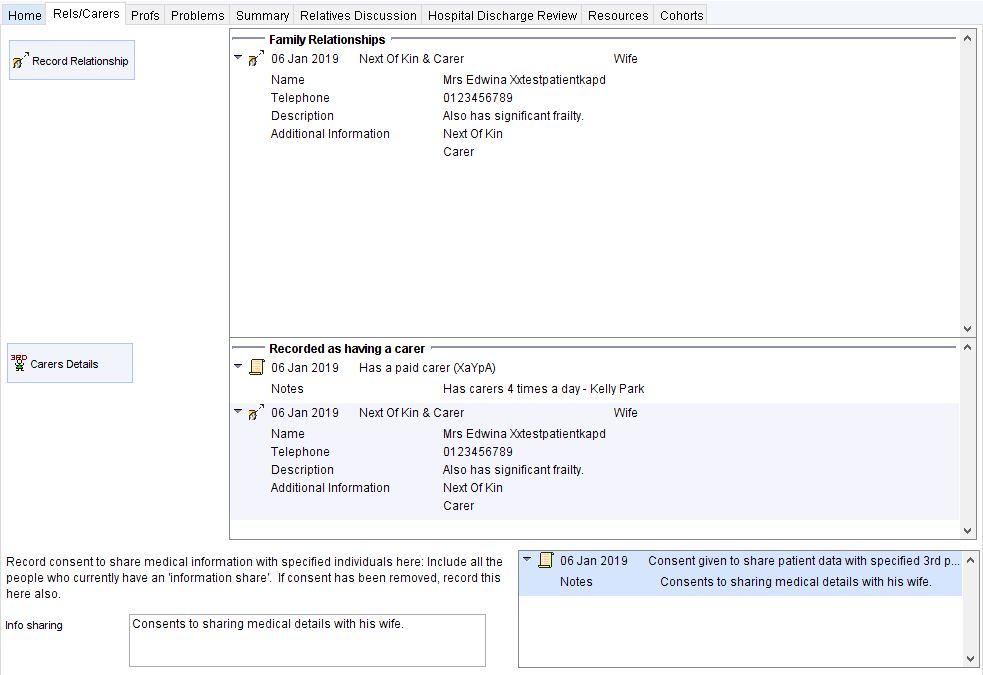
Professionals
The Profs page displays currently recorded professional relationships. Use the button to record new relationships, or right click on the relationships to amend them.
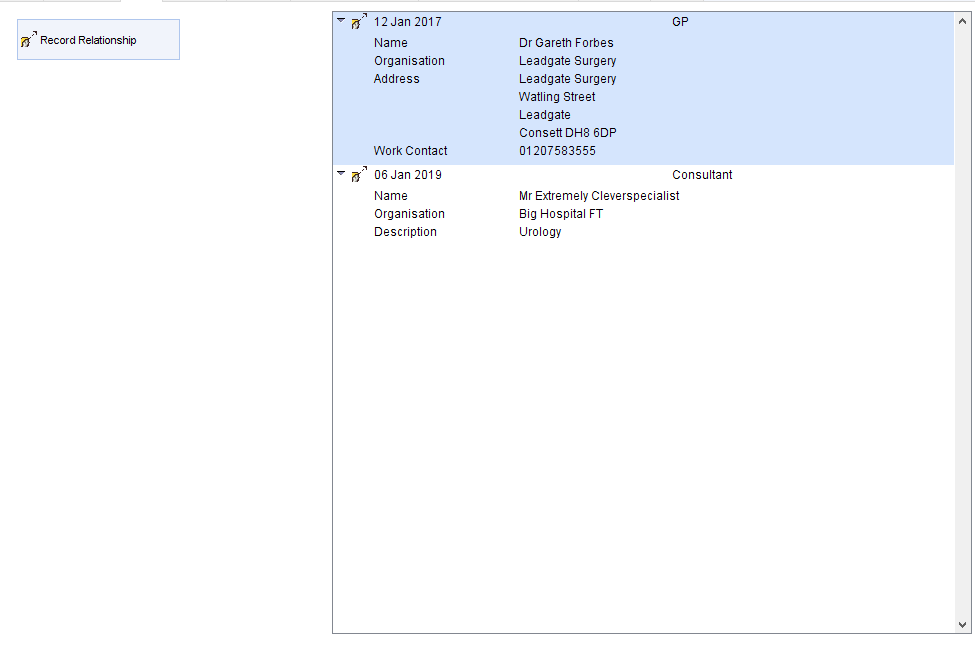
Problems / Summary
The Problems and Summary pages show the currently recorded problem lists depending on whether the GP practice uses the problems or summaries function to record the problem list.
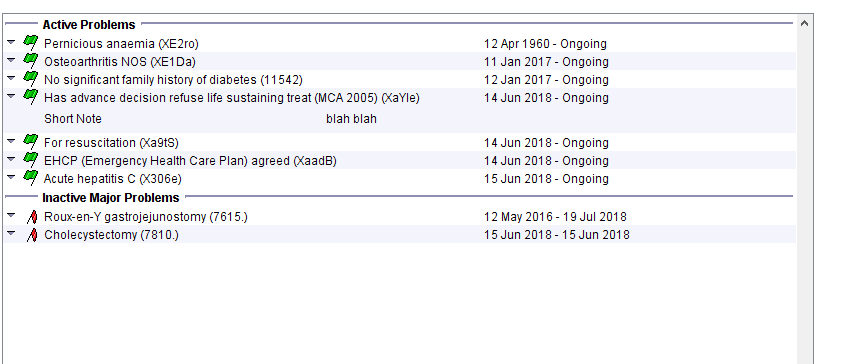
Relatives Discussion
This page allows viewing and recording of discussions with relatives.
![Discussion with Relatives
Place of care
Prognosis
Place of death
Discussion about CPR
Informed about CPR
preferred place of care - discussed wth fami!y (XaR4D
Z] Informing next of kin of prognosis (XaE7h)
Relative aware of prognosis (XaXI e)
Carer aware of prognosis (XaXI d)
Relative unaware of prognosis (XaXSG)
Carer unaware of prognosis (XaVzE)
Preferred place of death: discussed with family (XaR4u)
Preferred place of death discussed with significant other (Xalsx)
Discussion about CRP with family member (XabX8)
Resuscitation discussed with carer (XaLwd)
Family member informed of CPR clinical decision (XacqM)
Carer informed of CPR clinical decision (XacqN)
Consent to Discuss Medical Issues With Others
06 Jan 201 g Consent given to share patient data with specified 3rd
Notes
Consents to sharing medical details with his wif4
Discussions with RelattvesyCarers
06 Jan 201g
Informing next of kin of prognosis [XaE7h)
Notes
His wife is aware that he is very ill and onyl has a
shon time to liv4](https://cdrc.nhs.uk/wp-content/uploads/2022/10/image-355.png)
Resources
This page provides links to useful information and documents.
The Local Resources button will open a screen with your local resources and contact telephone numbers if this has been set up.
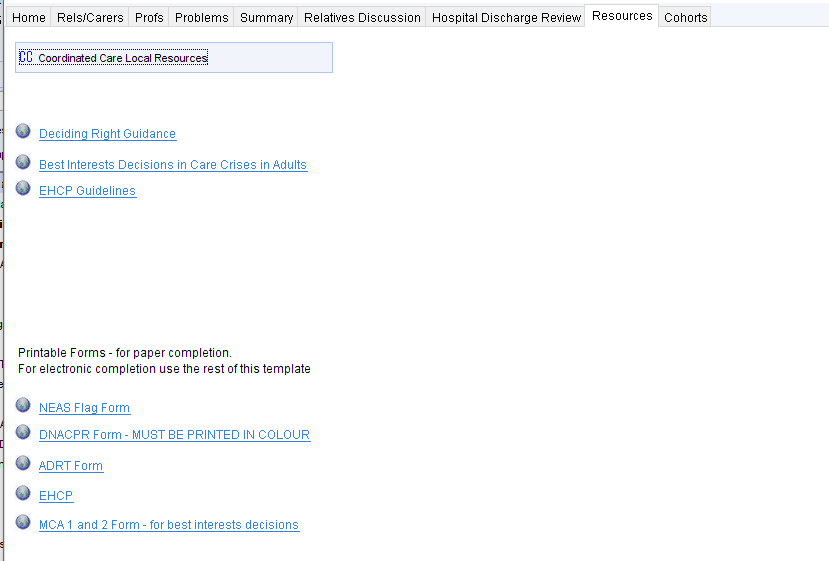
Cohorts
The DCS (which was the name preceding CDRC) system allows the creation of two cohorts, the concepts for which were originally designed in the County Durham multi-disciplinary, multi-agency working groups looking at care for complex patients.
- The coordinated care cohort – patients in need of co-ordinated care – patients with frailty, dementia and palliative care needs are automatically included. Additional patients can be added (or patients removed) using this page.
- The virtual ward – used in County Durham for patients in the coordinated cohort who have deteriorated acutely.
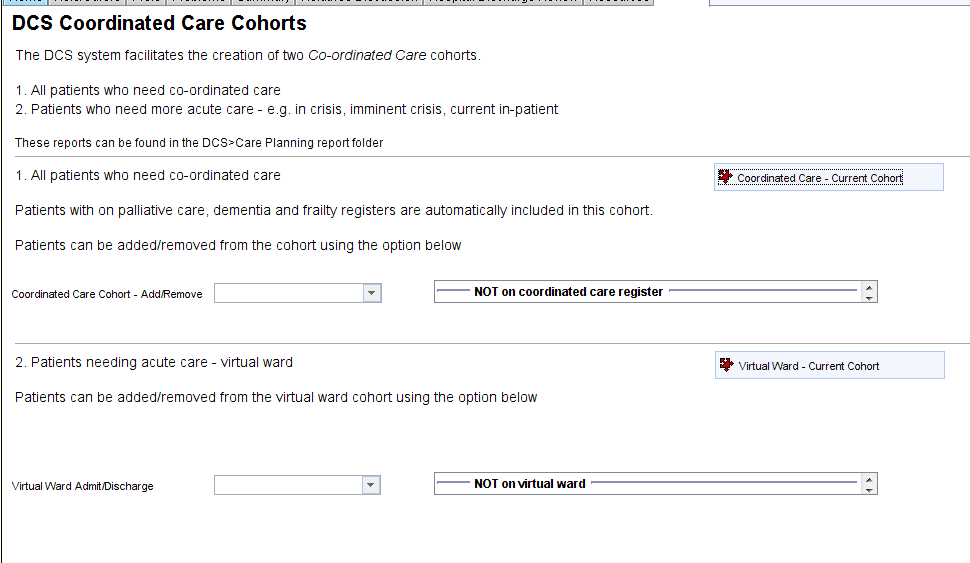
EHCP Template
How to Access:
In the lower left hand corner use the search bar, type in ‘EHCP – CDRC’ and select the following template:

Alternatively, press F12 and search for ‘EHCP – CDRC’, this will open the aforementioned template.
The EHCP – CDRC template home page shows most of the key information that will be pulled into a paper version of the EHCP.
Patients with a recorded EHCP will have this icon :

Clicking the icon will open the EHCP template.
Information relevant to the EHCP is displayed on the right of the template. To update or amend the information use the buttons on the left. To create the narrative parts of the EHCP, use the EHCP questionnaire: To create a new questionnaire use the Complete EHCP Questionnaire button; to update an existing questionnaire, right click on the current information and choose Copy Questionnaire.
Once the information on this screen and the other tabs has been checked for accuracy and completeness, clicking the Create EHCP button will allow you to print a paper version of the EHCP using the most recent information from the record.
Details on how to create a Digital Signature to sign SystmOne Word documents can be found in the How-To section of this manual.
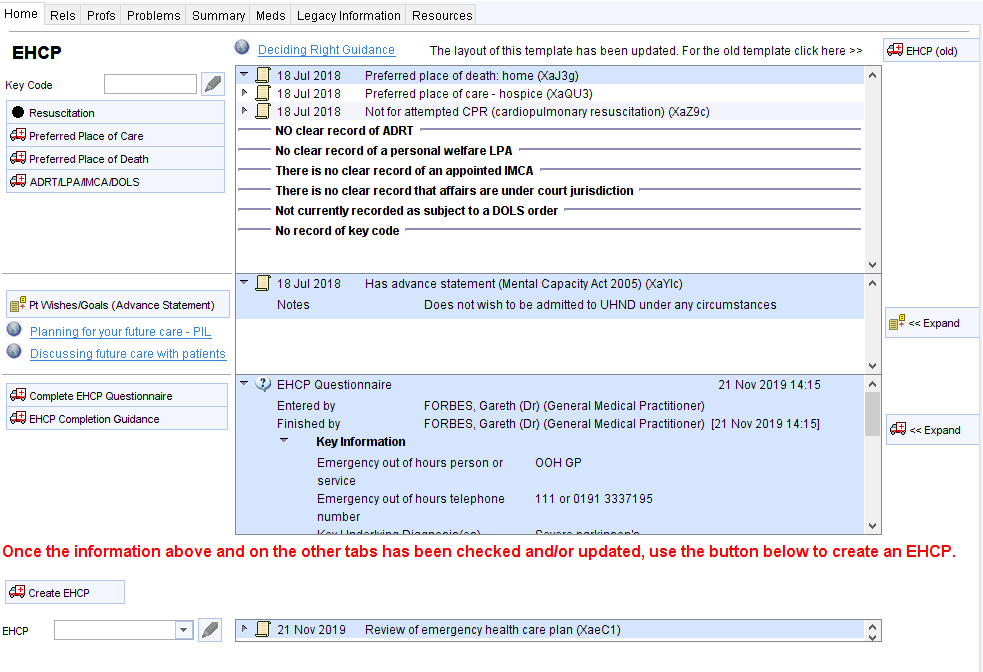
Additional information is displayed and can be recorded on the additional pages; Relatives, Professionals, Problems/Summary, Medication, Legacy Information, Resources.
Printing an EHCP
Once the information in the template is complete you can print an EHCP from the home page of the EHCP template
The EHCP will pull through all the up to date information from the medical record including:
- Emergency planning/anticipated emergencies
- Patient preferences including place of care and death
- Relatives and professional relationships.
- Medical problems, medication and allergies
- Carers details
Updating an EHCP
Updating the care plan is extremely easy. The co-ordinated care planning and/or EHCP templates are checked to make sure each page is up to date. The emergency planning section can be updated by right clicking on it, choosing ‘copy’ and copying over the old comments which can then be amended. There is therefore no need to write large amounts of text all over again. Once completed simple click the Create EHCPbutton on the home page of the EHCP template to create and record a new paper version of the EHCP.
DNACPR
Patient Status Alerts
Patients with a DNACPR code and a DNACPR Review date in the future (black spot icon) to the left of the GMS icon

Patients with a DNACPR code without a DNACPR Review date in the future (black spot icon) to the right of the GMS icon.

DNACPR Template
The DNACPR – CDRC template allows recording or and displays:
- Discussion about resuscitation with patient
- Discussion about resuscitation with others
- Current resuscitation status
The information required on the DNACPR can be recorded using the Complete New DNACPR Information button (which will also prompt you to add a DNACPR review recall).
The current DNA review recall date is displayed. Right click on this and choose Follow-on / Supercede to renew.
The Create DNACPR buttons can be used to create a paper copy of the DNACPR form. A colour printer would be needed to create a valid copy. During the COVID19 pandemic, black and white copies of the DNACPR form can be used to renew a DNACPR if they are stapled to the original colour version.
Details on how to create a Digital Signature to sign SystmOne Word documents can be found in the How -To section of this manual.
The most recent DNACPR form can be viewed by right clicking on the entry in the bottom view saying DNACPR Form to Mr XXX XXX and choose View Content

Review of DNACPR
The following search will identify patients whose current status is recorded as not for resuscitation but who don’t have a current DNACPR review recall or have a recall that is in the past or pending in the next 10 days.

Special Patient Notes
Special Patient Notes Template
The CDRC system facilitates the creation of a special patient note for the ambulance service.
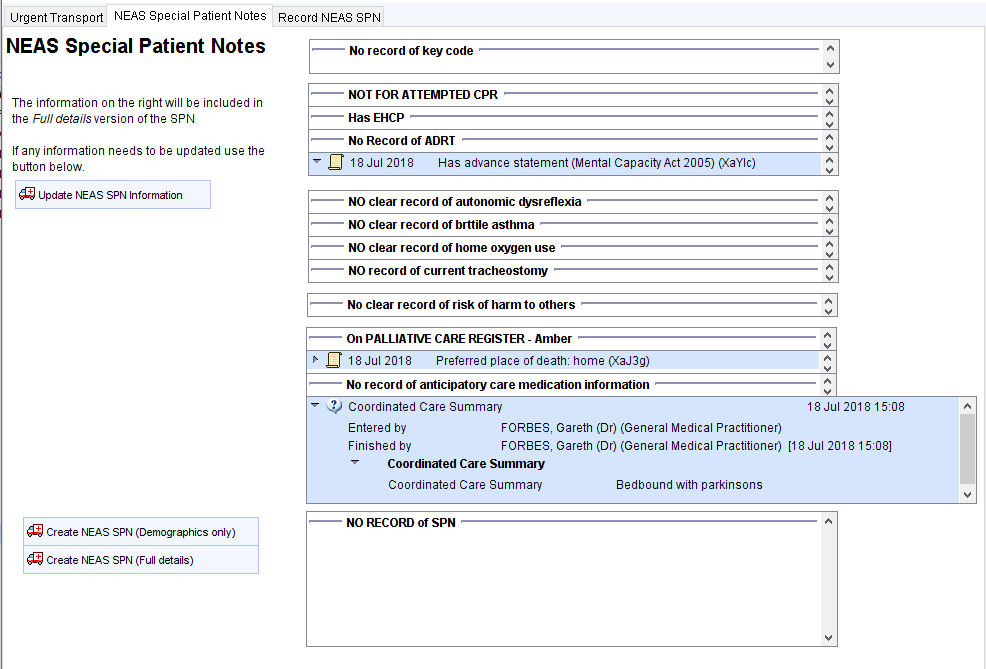
The information that will be pulled into the SPN is shown on the template.
If the information is incorrect, click the Update NEAS SPN Information button and update the information on the template that will open.
Once the information is complete, click the Create NEAS SPN button to create the SPN in Word. This should then be emailed to NEAS
